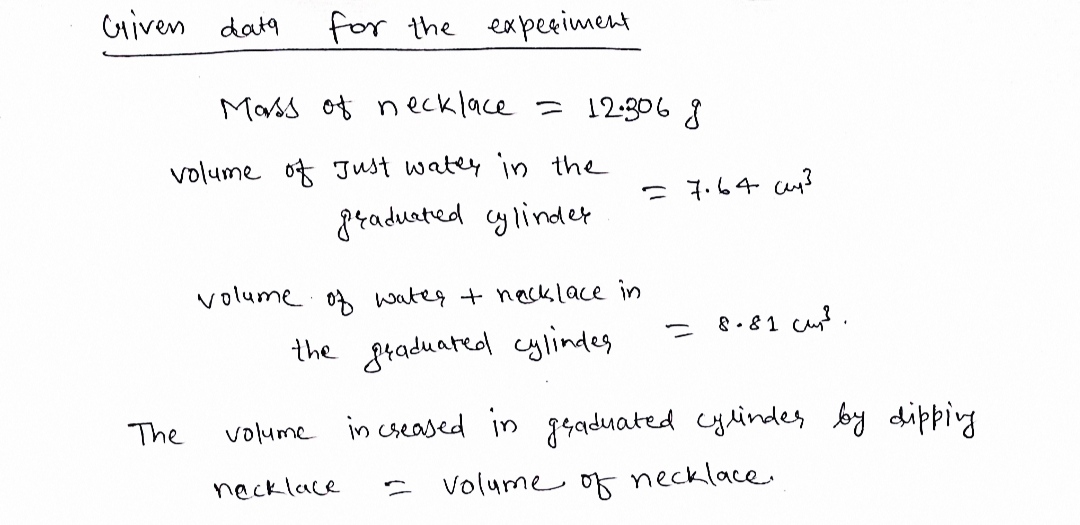11 bought a necklace which the seller said was made from silver. I decided to check if the necklace was truly silver. The density should be about the density of silver. The density the experiment in the lab. was done using water and a graduated cylinder to collect the following data: Mass of necklace = 12.306 g Volume of just water in the graduated cylinder = 7.64 cm3 Volume of water + necklace in the graduated cylinder = 8.81 cm3 1. What is the measured VOLUME of the necklace 2. What is the density of the necklace? Show all working 3. Considering just the data in the table and the calculations in the previous two questions: If a more precise balance had been used (i.e. the mass was measured with an additional significant figure), would the number of significant figures in the calculated density increase, decrease or remain the same? Explain in no more than one sentence. 4. Is the necklace made of silver? Density of silver is 10.49g/ cm3. Tick a. or b.: a. YES b. NO 5. Why is it that a larger piece of a metal that has a higher mass, has the same density as a smaller piece of metal that has a smaller mass? 6. Consider the procedure used to measure the volume of irregularly shaped solids. Why is it important to measure the mass before measuring the volume?
11 bought a necklace which the seller said was made from silver. I decided to check if the necklace was truly silver. The density should be about the density of silver. The density the experiment in the lab. was done using water and a graduated cylinder to collect the following data: Mass of necklace = 12.306 g Volume of just water in the graduated cylinder = 7.64 cm3 Volume of water + necklace in the graduated cylinder = 8.81 cm3 1. What is the measured VOLUME of the necklace 2. What is the density of the necklace? Show all working 3. Considering just the data in the table and the calculations in the previous two questions: If a more precise balance had been used (i.e. the mass was measured with an additional significant figure), would the number of significant figures in the calculated density increase, decrease or remain the same? Explain in no more than one sentence. 4. Is the necklace made of silver? Density of silver is 10.49g/ cm3. Tick a. or b.: a. YES b. NO 5. Why is it that a larger piece of a metal that has a higher mass, has the same density as a smaller piece of metal that has a smaller mass? 6. Consider the procedure used to measure the volume of irregularly shaped solids. Why is it important to measure the mass before measuring the volume?
Chemistry
10th Edition
ISBN:9781305957404
Author:Steven S. Zumdahl, Susan A. Zumdahl, Donald J. DeCoste
Publisher:Steven S. Zumdahl, Susan A. Zumdahl, Donald J. DeCoste
Chapter1: Chemical Foundations
Section: Chapter Questions
Problem 1RQ: Define and explain the differences between the following terms. a. law and theory b. theory and...
Related questions
Question

Transcribed Image Text:1I bought a necklace which the seller said was made from silver. I decided to check if the
necklace was truly silver. The density should be about the density of silver. The density the
experiment in the lab. was done using water and a graduated cylinder to collect the
following data:
Mass of necklace = 12.306 g
Volume of just water in the graduated cylinder = 7.64 cm3
Volume of water + necklace in the graduated cylinder = 8.81 cm3
1. What is the measured VOLUME of the necklace
2. What is the density of the necklace? Show all working
3. Considering just the data in the table and the calculations in the previous two
questions: If a more precise balance had been used (i.e. the mass was measured with
an additional significant figure), would the number of significant figures in the
calculated density increase, decrease or remain the same? Explain in no more than one
sentence.
4. Is the necklace made of silver? Density of silver is 10.49g/ cm3. Tick a. or b.:
a. YES
b. NO
5. Why is it that a larger piece of a metal that has a higher mass, has the same density as a
smaller piece of metal that has a smaller mass?
6. Consider the procedure used to measure the volume of irregularly shaped solids. Why is it
important to measure the mass before measuring the volume?
Expert Solution
Step 1

Trending now
This is a popular solution!
Step by step
Solved in 3 steps with 3 images

Knowledge Booster
Learn more about
Need a deep-dive on the concept behind this application? Look no further. Learn more about this topic, chemistry and related others by exploring similar questions and additional content below.Recommended textbooks for you

Chemistry
Chemistry
ISBN:
9781305957404
Author:
Steven S. Zumdahl, Susan A. Zumdahl, Donald J. DeCoste
Publisher:
Cengage Learning

Chemistry
Chemistry
ISBN:
9781259911156
Author:
Raymond Chang Dr., Jason Overby Professor
Publisher:
McGraw-Hill Education

Principles of Instrumental Analysis
Chemistry
ISBN:
9781305577213
Author:
Douglas A. Skoog, F. James Holler, Stanley R. Crouch
Publisher:
Cengage Learning

Chemistry
Chemistry
ISBN:
9781305957404
Author:
Steven S. Zumdahl, Susan A. Zumdahl, Donald J. DeCoste
Publisher:
Cengage Learning

Chemistry
Chemistry
ISBN:
9781259911156
Author:
Raymond Chang Dr., Jason Overby Professor
Publisher:
McGraw-Hill Education

Principles of Instrumental Analysis
Chemistry
ISBN:
9781305577213
Author:
Douglas A. Skoog, F. James Holler, Stanley R. Crouch
Publisher:
Cengage Learning

Organic Chemistry
Chemistry
ISBN:
9780078021558
Author:
Janice Gorzynski Smith Dr.
Publisher:
McGraw-Hill Education

Chemistry: Principles and Reactions
Chemistry
ISBN:
9781305079373
Author:
William L. Masterton, Cecile N. Hurley
Publisher:
Cengage Learning

Elementary Principles of Chemical Processes, Bind…
Chemistry
ISBN:
9781118431221
Author:
Richard M. Felder, Ronald W. Rousseau, Lisa G. Bullard
Publisher:
WILEY